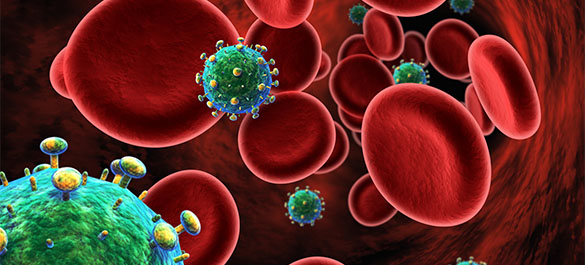
การจัดการภาวะแทรกซ้อนยาต้านรีโทรไวรัส ตอน 9
- โดย ภก.วิชญ์ภัทร ธรานนท์
- 8 ตุลาคม 2561
- Tweet

สาเหตุ
ภาวะกระดูกบางพบในเพศหญิงวัยหมดประจำเดือนหรือชายที่มีอายุตั้งแต่ 50 ปีขึ้นไปที่มีความหนาแน่นของกระดูก (bone mineral density, BMD) ลดลงหรือค่า T-score -1 ถึง -2.5 ซึ่งพบในผู้ป่วยติดเชื้อเอชไอวีร้อยละ 60 ทำให้พบความชุกของกระดูกหักในผู้ป่วยติดเชื้อเอชไอวีเพิ่มขึ้น มักจะไม่มีอาการจนกระทั่งกระดูกหัก ปัจจัยเสี่ยงของภาวะกระดูกบางในผู้ป่วยติดเชื้อเอชไอวีเหมือนกับที่พบในประชากรทั่วไป คือ เป็นเพศหญิง อายุมาก โรคเบาหวาน ฮอร์โมนเพศต่ำ มีประวัติกระดูกสะโพกหักในครอบครัว ดัชนีมวลกายต่ำ (ตั้งแต่ 19 กก./ตร.ม.หรือน้อยกว่า) ขาดวิตามินดี สูบบุหรี่ ไม่ค่อยเคลื่อนไหวร่างกาย ดื่มแอลกฮอล์มาก ได้รับยาสเตียรอยด์ เช่น ได้รับยา prednisolone มากกว่า 5 มิลลิกรัม/วัน นาน 3 เดือนหรือมากกว่า
กรณี พบค่า T-score ≤ 2.5 ในเพศหญิงวัยหมดประจำเดือนหรือชายที่มีอายุตั้งแต่ 50 ปีขึ้นไป หรือในผู้หญิงก่อนหมดประจำเดือน และผู้ที่อายุน้อยกว่า 50 ปีที่มีค่า Z-score ≤ -2 และมีกระดูกหัก พบในผู้ติดเชื้อเอชไอวีร้อยละ 10 – 15 การวินิจฉัยภาวะกระดูกบางและกระดูกพรุน คือ การวัดความหนาแน่นของกระดูกด้วย DXA และหาสาเหตุอื่นๆที่อาจเป็นสาเหตุของกระดูกพรุน คือ ฮอร์โมนพาราไทรอยด์เกิน ฮอร์โมนไทรอยด์เกิน ฮอร์โมนเพศต่ำหรือไม่มีประจำเดือน เบาหวาน และโรคตับเรื้อรัง
การตายของกระดูก หมายถึง การขาดเลือดของกระดูกยาว ทำให้เกิดอาการปวดเฉียบพลันร่วมกับการมีหัวกระดูกตายจากการขาดเลือด เป็นภาวะแทรกซ้อนที่พบไม่บ่อยแต่พบมากขึ้นในผู้ป่วยติดเชื้อเอชไอวี มีสาเหตุอาจจะเกิดจากการติดเชื้อเอชไอวีเอง ยาต้านเอชไอวี จำนวน CD-4 ต่ำ หรือติดยาเสพติดชนิดฉีด อาการของความผิดปกติของกระดูกจะค่อยเป็นค่อยไปและขึ้นกับตำแหน่งที่มีความผิดปกติ โดยมักมีอาการปวดข้อ ร้อยละ 85 เกิดที่หัววของกระดูกต้นขา (femeral head) อาจเป็นข้างเดียวหรือ 2 ข้าง ตำแหน่งอื่นที่พบได้แต่ไม่บ่อย คือ ข้อไหล่ และข้อเข่า การวินิจฉัย คือ การทำภาพรังสีคอมพิวเตอร์และเอ็มอาร์ไอ
ยากลุ่ม NNRTIs ที่ทำให้เกิดกระดูกบางหรือกระดูกพรุนมากที่สุด คือ ยาทีโนโฟเวียร์ (tenofovir disoproxil fumarate; TDF) จากการศึกษาพบว่า TDF สัมพันธ์กับการลดลงของความหนาแน่นของกระดูกมากกว่าบยาซิโดวูดีน (zidovudine) สตาวูดีน (stavudine) และ อะบาคาเวียร์(abacavir) ยากลุ่ม NNRTIs และ PIs ก็มีข้อมูลที่พบการลดลงของความหนาแน่นของกระดูกจากหลายการศึกษาที่มีการให้ร่วมกับยากลุ่ม NRTIs ชนิดต่างๆกัน
การป้องกัน
หลีกเลี่ยงการใช้ยาทีโนโฟเวียร์ (TDF) หรือยากลุ่ม PIs ในผู้ที่มีความเสี่ยงที่จะเกิดภาวะแทรกซ้อนทางกระดูก กำจัดหรือลดปัจจัยเสี่ยงอื่นๆ ดังกล่าวข้างต้น เช่น งดการใช้ยาสเตียรอยด์ สุราและแอลกฮอล์ ฯลฯไม่แนะนำให้ตรวจคัดกรองด้วยภาพถ่ายรังสีกระดูก (plain film) เนื่องจาก ไม่ไวพอในการวินิจฉัยภาวะหัวกระดูกตายจากการขาดเลือดในผู้ที่ไม่มีอาการ
ติดตามค่าทางห้องปฏิบัติการที่เกี่ยวข้อง เช่น ค่า bone mineral density (BMD), serum parathyroid hormone, 25-(OH) vitamin D level
การรักษา
กำจัดปัจจัยเสี่ยง ให้การรักษาตามอาการ ได้แก่ ลดน้ำหนักที่กดลงบนข้อนั้น และการใช้ยาแก้ปวด ถ้ามีอาการปวดมากที่ไม่สามารถควบคุมได้ด้วยยาแก้ปวดหรือเริ่มมีข้อจำกัดในการใช้งานของข้อนั้นๆ ให้พิจารณาผ่าตัดเปลี่ยนข้อ โดยเฉพาะข้อสะโพก
พิจารณาเปลี่ยนยาทีโนโฟเวียร์ (TDF) ไปเป็น tenofovir alafenamide (TAF) เพราะ TAF สัมพันธ์เพียงเล็กน้อยกับภาวะกระดูกบางและกระดูกพรุน เมื่อเทียบกับ TDF พบว่าผู้ป่วยมีค่า BMD ดีขึ้นภายหลังการเปลี่ยนยาจาก TDF เป็น TAF โดยที่ยังคงมีประสิทธิภาพและความปลอดภัยเทียบเท่า TDF อย่างไรก็ตาม แนะนำให้ติดตามภาวะกระดูกบางและกระดูกพรุนในผู้ป่วยที่ได้รับยา TAF เป็นระยะเวลานาน
บรรณานุกรม:
- Department of disease control, Thailand National Guidelines on HIV/AIDS Treatment and Prevention 2017. availavle from http://www.thaiaidssociety.org/images/PDF/ hiv_thai_guideline _2560.pdf.
- Cohen DE, Mayer KH. Primary care issues for HIV-infected patients. Infect Dis Clin N Am 21 (2007): 49–70.
- วีรวัฒน์ มโนสุทธิ. Current management of complication of antiretroviral therapy. ใน: ชาญกิจ พุฒิเลอพงศ์, ณัฏฐดา อารีเปี่ยม, แสง อุษยาพร, บรรณาธิการ. Pharmacotherapy in infectious disease VII. กรุงเทพมหานคร. สำนักพิมพ์แห่งจุฬาลงกรณ์มหาวิทยาลัย. 2558, หน้า 198-201.
- Group TISS. Initiation of Antiretroviral Therapy in Early Asymptomatic HIV Infection. New England Journal of Medicine. 2015;373(9):795-807.
- Group TTAS. A Trial of Early Antiretrovirals and Isoniazid Preventive Therapy in Africa. New England Journal of Medicine. 2015;373(9):808-22.
- Ayoko R. Bossou SC, Karen K. O’Brien, Catherine A. Opere, Christopher J. Destache. Preventive HIV Vaccines: Progress and Challenges. US Pharmacist. 2015 OCTOBER 16, 2015:46-50.
- รัชนู เจริญพักตร์ และ ชาญกิจ พุฒิเลอพงศ์. Current update on HIV/AIDs treatment guideline in 2017. ใน: ชาญกิจ พุฒิเลอพงศ์, โชติรัตน์ นครานุรักษ์, และ แสง อุษยาพร, บรรณาธิการ. Pharmacotherapy in infectious disease IX. กรุงเทพมหานคร. สำนักพิมพ์แห่งจุฬาลงกรณ์มหาวิทยาลัย. 2560, หน้า 342-364.
- Wada N JL, Cohen M, French A, Phair J, Munoz A. Cause-specific life expectancies after 35 years of age for human immunodeficiency syndrome-infected and human immunodeficiency syndrome-negative individuals followed simultaneously in long-term cohort studies, 1984-2008. Am J Epidermol. 2013; 177: 116-125.
- Department of Health and Human Services. Guidelines for the Use of Antiretroviral Agents in Adults and Adolescents Living with HIV Available from: https://aidsinfo.nih.gov/guidelines.
- O'Brien ME, Clark RA, Besch CL, Myers L, Kissinger P. Patterns and correlates of discontinuation of the initial HAART regimen in an urban outpatient cohort. Journal of acquired immune deficiency syndromes (1999). 2003;34(4):407-14.
- Kiertiburanakul S, Luengroongroj P, Sungkanuparph S. Clinical characteristics of HIV-infected patients who survive after the diagnosis of HIV infection for more than 10 years in a resource-limited setting. Journal of the International Association of Physicians in AIDS Care (Chicago, Ill : 2002). 2012;11(6):361-5.
- Wiboonchutikul S, Sungkanuparph S, Kiertiburanakul S, Chailurkit LO, Charoenyingwattana A, Wangsomboonsiri W, et al. Vitamin D insufficiency and deficiency among HIV-1-infected patients in a tropical setting. Journal of the International Association of Physicians in AIDS Care (Chicago, Ill : 2002). 2012;11(5):305-10.
- Wilde JT, Lee CA, Collins P, Giangrande PL, Winter M, Shiach CR. Increased bleeding associated with protease inhibitor therapy in HIV-positive patients with bleeding disorders. British journal of haematology. 1999;107(3):556-9.
- European AIDS Clinical Society. EACS Guidelines version 8.1-October 2016. Available from http://www.eacsociety.org/files/guidelines_8.1-english.pdf.
- ศศิโสภิณ เกียรติบูรณกุล. การดูแลรักษาผู้ติดเชื้อเอชไอวีแบบผู้ป่วยนอก.กรุงเทพฯ : ภาควิชาอายุรศาสตร์ คณะแพทยศาตร์โรงพยาบาลรามาธิบดี มหาวิทยาลัยมหิดล, 2557
- Morse CG, Mican JM, Jones EC, Joe GO, Rick ME, Formentini E, et al. The incidence and natural history of osteonecrosis in HIV-infected adults. Clinical infectious diseases : an official publication of the Infectious Diseases Society of America. 2007;44(5):739-48.
- Woodward CL, Hall AM, Williams IG, Madge S, Copas A, Nair D, et al. Tenofovir-associated renal and bone toxicity. HIV medicine. 2009;10(8):482-7.
- Wang H, Lu X, Yang X, Xu N. The efficacy and safety of tenofovir alafenamide versus tenofovir disoproxil fumarate in antiretroviral regimens for HIV-1 therapy: Meta-analysis. Medicine. 2016;95(41):e5146.
- Redig AJ, Berliner N. Pathogenesis and clinical implications of HIV-related anemia in 2013. Hematology American Society of Hematology Education Program. 2013;2013:377-81.
- Assefa M, Abegaz WE, Shewamare A, Medhin G, Belay M. Prevalence and correlates of anemia among HIV infected patients on highly active anti-retroviral therapy at Zewditu Memorial Hospital, Ethiopia. BMC Hematology. 2015;15:6.
- de Gaetano Donati K, Cauda R, Iacoviello L. HIV Infection, Antiretroviral Therapy and Cardiovascular Risk. Mediterranean Journal of Hematology and Infectious Diseases. 2010;2(3):e2010034.
- Group TDS. Class of Antiretroviral Drugs and the Risk of Myocardial Infarction. New England Journal of Medicine. 2007;356(17):1723-35.
- Tsiodras S, Mantzoros C, Hammer S, Samore M. Effects of protease inhibitors on hyperglycemia, hyperlipidemia, and lipodystrophy: a 5-year cohort study. Archives of internal medicine. 2000;160(13):2050-6.
- วราภณ วงศ์ถาวราวัฒน์. Diagnosis and classification of Diabetes Mellitus. ใน: ธิติ สนับบุญ, บรรณาธิการ. แนวทางเวชปฏิบัติทางต่อมไร้ท่อ. กรุงเทพมหานคร.โรงพิมพ์แห่งจุฬาลงกรณ์มหาวิทยาลัย. 2560, หน้า 1-9.
- ชาญกิจ พุฒิเลอพงศ์. Clinical management for dyslipidemia in HIV-infected patients. ใน: ชาญกิจ พุฒิเลอพงศ์ และ ณัฏฐดา อารีเปี่ยม, บรรณาธิการ. Pharmacotherapy in infectious disease VI. กรุงเทพมหานคร. คอนเซ็พท์พริ้นท์. 2557, หน้า 198-201.
- Dube MP, Stein JH, Aberg JA, Fichtenbaum CJ, Gerber JG, Tashima KT, et al. Guidelines for the evaluation and management of dyslipidemia in human immunodeficiency virus (HIV)-infected adults receiving antiretroviral therapy: recommendations of the HIV Medical Association of the Infectious Disease Society of America and the Adult AIDS Clinical Trials Group. Clinical infectious diseases : an official publication of the Infectious Diseases Society of America. 2003;37(5):613-27.
- Hoffman RM, Currier JS. Management of antiretroviral treatment-related complications. Infectious disease clinics of North America. 2007;21(1):103-32, ix.
- Husain NEOS, Ahmed MH. Managing dyslipidemia in HIV/AIDS patients: challenges and solutions. HIV/AIDS (Auckland, NZ). 2015;7:1-10.
- Kiertiburanakul S, Sungkanuparph S, Charoenyingwattana A, Mahasirimongkol S, Sura T, Chantratita W. Risk factors for nevirapine-associated rash among HIV-infected patients with low CD4 cell counts in resource-limited settings. Current HIV research. 2008;6(1):65-9.
- Murphy RL. Defining the toxicity profile of nevirapine and other antiretroviral drugs. Journal of acquired immune deficiency syndromes (1999). 2003;34 Suppl 1:S15-20.
- Department of Health and Human Services. HIV and Lactic Acidosis. Available from: https://aidsinfo.nih.gov/understanding-hiv-aids/fact-sheets/22/68/hiv-and-lactic-acidosis.
- Grinspoon S, Carr A. Cardiovascular Risk and Body-Fat Abnormalities in HIV-Infected Adults. New England Journal of Medicine. 2005;352(1):48-62.
- Simpson D, Estanislao L, Evans S , McArthur J, Marcusd K, Truffa M et,al. HIV-associated neuromuscular weakness syndrome. AIDS (London, England). 2004;18(10):1403-12.
- Hall AM, Hendry BM, Nitsch D, Connolly JO. Tenofovir-associated kidney toxicity in HIV-infected patients: a review of the evidence. American journal of kidney diseases : the official journal of the National Kidney Foundation. 2011;57(5):773-80.
- Chaisiri K, Bowonwatanuwong C, Kasettratat N, Kiertiburanakul S. Incidence and risk factors for tenofovir-associated renal function decline among Thai HIV-infected patients with low-body weight. Current HIV research. 2010;8(7):504-9.
- Schwarzwald H, Gillespie S. Management of Antiretroviral-Associated Complications. Available from: https://bipai.org/sites/bipai/files/5-Mgt-assoc-complications.pdf
- ศศิโสภิณ เกียรติบูรณกุล. Practical management of complication-associated with ARVใน: นารัต เกษตรทัต, ชาญกิจ พุฒิเลอพงศ์ และ ณัฏฐดา อารีเปี่ยม, บรรณาธิการ. Pharmacotherapy in infectious disease VI. กรุงเทพมหานคร. คอนเซ็พท์พริ้นท์. 2554, หน้า 317-346.


